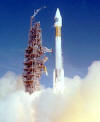ATLAS II
 Mission Mission
Atlas II is a member of the Atlas family of launch vehicles, which evolved from the successful Atlas intercontinental ballistic missile (ICBM) program. It is designed to launch payloads into low earth orbit, geosynchronous transfer orbit or geosynchronous orbit.
Features
Atlas II provides higher performance than the earlier Atlas I by using engines with greater thrust and longer fuel tanks for both stages. The total thrust capability of the Atlas II of 490,000 pounds enables the booster to lift payloads of 6,100 pounds in geosynchronous orbit (22,000 miles-plus). This series uses an improved Centaur upper stage – the world’s first high-energy propellant stage – to increase its payload capability. Atlas II also has lower-cost electronics, an improved flight computer and longer propellant tanks than its predecessor, Atlas I.
Background
Atlas II's are launched from Cape Canaveral Air Force Station, Fla., by the 45th Space Wing. The final West Coast Atlas II launch was accomplished December 2003 by the 30th Space Wing, Vandenberg AFB, Calif. The Atlas was originally fielded as an ICBM in the late 1950s. On Oct. 31, 1959, the first Atlas, a D model stored horizontally, was placed on alert at Vandenberg AFB by the 576th Strategic Missile Squadron. Atlas E and F models were the first ICBMs to be stored vertically in underground silos and raised by elevators to an above-ground position for launch. The Air Force replaced the Atlas ICBMs with Titan ICBMs and converted the E and F models into space launch vehicles in the late 1960s. The last refurbished Atlas vehicle was launched from Vandenberg AFB in 1995 carrying a satellite for the Defense Meteorological Satellite Program. NASA used the Atlas as a space launch vehicle as early as 1958. Atlas served as the launch vehicle for Project Score, an instrumentation package developed by the U.S. Army Signal Corps that became the world’s first communications satellite. The satellite broadcast President Eisenhower’s pre-recorded Christmas message around the world. An Atlas booster carried U.S. astronaut John Glenn into orbit under Project Mercury, the first U.S. manned space program. Atlas Centaur vehicles also launched Mariner and Pioneer planetary probes. In May 1988, the Air Force chose General Dynamics (now Lockheed-Martin) to develop the Atlas II vehicle, primarily to launch Defense Satellite Communications System payloads and for commercial users as a result of Atlas I launch failures in the late 1980s.
General Characteristics
Primary function: Launch vehicle
Primary contractor: Lockheed Martin - airframe, assembly, avionics, test and systems integration
Principal subcontractors: Rocketdyne (Atlas engine, MA-5); Pratt & Whitney (Centaur engine, RL-10) and Honeywell & Teledyne (avionics)
Power Plant: Three MA-5A Rocketdyne engines, two Pratt & Whitney RL10A-4 Centaur engines
Thrust: 494,500 pounds
Length: Up to 156 feet (47.54 meters); 16-foot-high engine cluster (4.87 meters)
Core Diameter: 10 feet (3.04 meters)
Gross Liftoff Weight: 414,000 pounds (204,343 kilograms)
First Launch: Feb. 10, 1992
Models: II, IIA, and IIAS
Launch Site: Cape Canaveral AFS, Fla. |